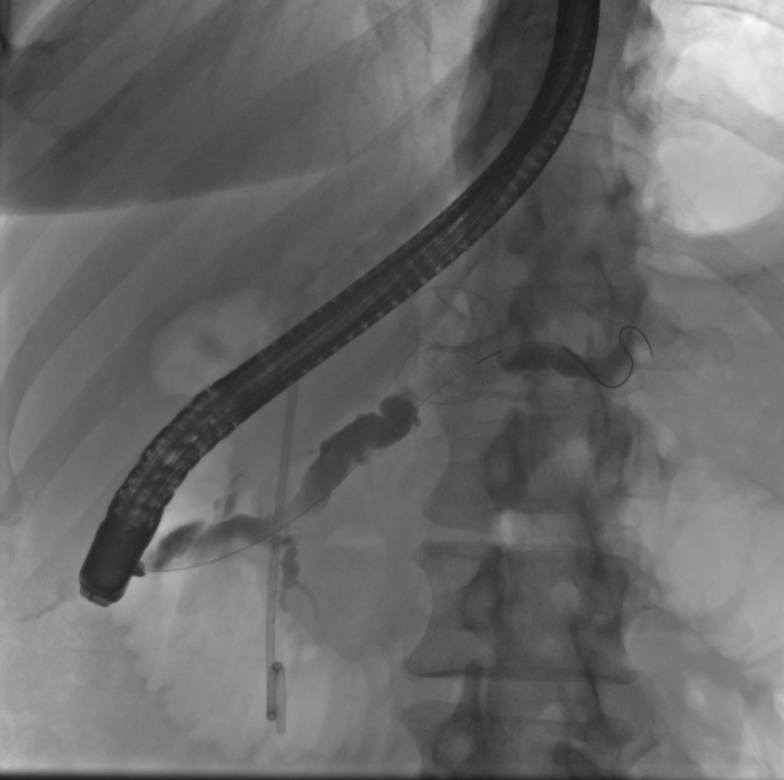Tuesday Poster Session
Category: Biliary/Pancreas
P4402 - Santorinicele Complicating Necrotizing Pancreatitis in a Patient With Incomplete Pancreas Divisum
Tuesday, October 28, 2025
10:30 AM - 4:00 PM PDT
Location: Exhibit Hall

Rebecca Aquino, MD
University of Kentucky Chandler Medical Center
Lexington, KY
Presenting Author(s)
Rebecca Aquino, MD1, Kshitij Thakur, MD2
1University of Kentucky Chandler Medical Center, Lexington, KY; 2University of Kentucky, Lexington, KY
Introduction: Santorinicele is a cystic dilation of the distal portion of the accessory pancreatic duct (duct of Santorini), typically near the minor papilla. It is often associated with anatomical variants such as pancreas divisum and may contribute to ductal outflow obstruction. Although rare, Santorinicele can result in recurrent idiopathic pancreatitis or exacerbate pancreatitis from other causes. Management typically involves endoscopic intervention, including minor papillotomy and pancreatic duct stenting.
Case Description/
Methods: We present the case of a 66-year-old male with a recent episode of acute pancreatitis who returned with worsening abdominal pain and nausea one month later. Computed tomography of the abdomen and pelvis revealed necrotizing pancreatitis with a large peripancreatic fluid collection. The patient underwent percutaneous drainage by interventional radiology, followed by cystogastrostomy. Initial endoscopic retrograde cholangiopancreatography (ERCP) was unsuccessful due to duodenal edema limiting visualization of the major and minor papillae. Magnetic resonance cholangiopancreatography (MRCP) revealed a cystic dilation in the intramural portion of the accessory duct, consistent with Santorinicele, as well as incomplete pancreas divisum. Notably, MRCP also demonstrated biliary debris within the common bile duct. A repeat ERCP was performed weeks later. The bile duct was cannulated, and biliary sludge was removed. The Santorinicele was confirmed, and the incomplete ductal fusion was again noted. Minor papillotomy was performed, and a stent was placed into the duct of Santorini, resulting in clinical improvement.
Discussion: Pancreas divisum, seen in approximately 10% of the population, arises from incomplete fusion of the dorsal and ventral pancreatic ducts during embryogenesis. Santorinicele, particularly in this context, can impair pancreatic drainage, elevate intraductal pressure, and precipitate pancreatitis. In this patient, the presence of biliary debris raises the possibility of a biliary etiology; however, the Santorinicele likely played a contributory role, exacerbating the necrotizing pancreatitis.
In patients with recurrent or unexplained pancreatitis, particularly with known anatomical variants such as pancreas divisum, Santorinicele should be considered. Early recognition and intervention, including minor papillotomy and stenting, can relieve ductal obstruction and improve outcomes.

Figure: Cystic dilation of the terminal dorsal pancreatic duct (Santorinicele).
Disclosures:
Rebecca Aquino indicated no relevant financial relationships.
Kshitij Thakur indicated no relevant financial relationships.
Rebecca Aquino, MD1, Kshitij Thakur, MD2. P4402 - Santorinicele Complicating Necrotizing Pancreatitis in a Patient With Incomplete Pancreas Divisum, ACG 2025 Annual Scientific Meeting Abstracts. Phoenix, AZ: American College of Gastroenterology.
1University of Kentucky Chandler Medical Center, Lexington, KY; 2University of Kentucky, Lexington, KY
Introduction: Santorinicele is a cystic dilation of the distal portion of the accessory pancreatic duct (duct of Santorini), typically near the minor papilla. It is often associated with anatomical variants such as pancreas divisum and may contribute to ductal outflow obstruction. Although rare, Santorinicele can result in recurrent idiopathic pancreatitis or exacerbate pancreatitis from other causes. Management typically involves endoscopic intervention, including minor papillotomy and pancreatic duct stenting.
Case Description/
Methods: We present the case of a 66-year-old male with a recent episode of acute pancreatitis who returned with worsening abdominal pain and nausea one month later. Computed tomography of the abdomen and pelvis revealed necrotizing pancreatitis with a large peripancreatic fluid collection. The patient underwent percutaneous drainage by interventional radiology, followed by cystogastrostomy. Initial endoscopic retrograde cholangiopancreatography (ERCP) was unsuccessful due to duodenal edema limiting visualization of the major and minor papillae. Magnetic resonance cholangiopancreatography (MRCP) revealed a cystic dilation in the intramural portion of the accessory duct, consistent with Santorinicele, as well as incomplete pancreas divisum. Notably, MRCP also demonstrated biliary debris within the common bile duct. A repeat ERCP was performed weeks later. The bile duct was cannulated, and biliary sludge was removed. The Santorinicele was confirmed, and the incomplete ductal fusion was again noted. Minor papillotomy was performed, and a stent was placed into the duct of Santorini, resulting in clinical improvement.
Discussion: Pancreas divisum, seen in approximately 10% of the population, arises from incomplete fusion of the dorsal and ventral pancreatic ducts during embryogenesis. Santorinicele, particularly in this context, can impair pancreatic drainage, elevate intraductal pressure, and precipitate pancreatitis. In this patient, the presence of biliary debris raises the possibility of a biliary etiology; however, the Santorinicele likely played a contributory role, exacerbating the necrotizing pancreatitis.
In patients with recurrent or unexplained pancreatitis, particularly with known anatomical variants such as pancreas divisum, Santorinicele should be considered. Early recognition and intervention, including minor papillotomy and stenting, can relieve ductal obstruction and improve outcomes.

Figure: Cystic dilation of the terminal dorsal pancreatic duct (Santorinicele).
Disclosures:
Rebecca Aquino indicated no relevant financial relationships.
Kshitij Thakur indicated no relevant financial relationships.
Rebecca Aquino, MD1, Kshitij Thakur, MD2. P4402 - Santorinicele Complicating Necrotizing Pancreatitis in a Patient With Incomplete Pancreas Divisum, ACG 2025 Annual Scientific Meeting Abstracts. Phoenix, AZ: American College of Gastroenterology.
